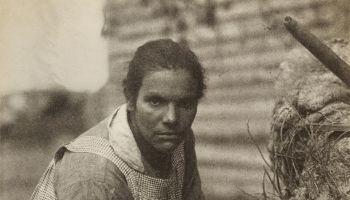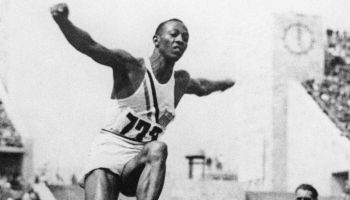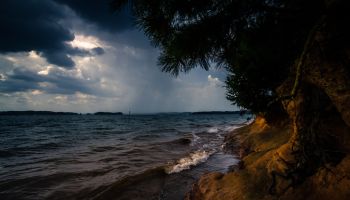FRESNO, California– Just east of Victorville in California’s Mojave Desert two bluffs rise 3,000 feet (900 meters) from the valley floor. A 1949 map by the U.S. Geological Survey officially gave them the name locals had called them for as long as anyone could remember: Pickaninny Buttes.
The name, a pejorative term that represents a caricature of black children, was likely bestowed because African Americans attempted a settlement near the Lucerne Valley at the turn of the last century. Whatever the reason, it stuck — and still has the propensity to shock.
“Good grief,” moaned Leon Jenkins, president of the Los Angeles chapter of the National Association for the Advancement of Colored People, a civil rights group, when told about the site. “That is just about as offensive as it gets because nowhere in the English language was that used other than to be a slur at little girls.”
Pickaninny Buttes is one of thousands of places across the United States still saddled with names that are an insight into the country’s divisive past, when demeaning names given to areas settled by ethnic or racial minorities were recorded on official government maps and often stuck. Some, like Wop Draw in Wyoming; Jewtown, Georgia; Beaner Lake, Washington state; Wetback Tank reservoir in New Mexico and Polack Lake in Michigan, can sound rudely impolitic to the ears of a more inclusive society.
Others, such as the former Olympic ski resort of Squaw Valley near Lake Tahoe have become so ingrained in the vernacular that they’re spoken without a second thought. And yet, nine states are on a mission to scrub “squaw” from their maps, a slang word first given to Native American women that came to mean both a part of the female genitalia and a woman of ill repute. California is not among those states, to the continuing frustration of many regional Indian tribes.
“It’s so disrespectful I’m not even going to say the name,” said Chairman James Ramos of the San Manuel Band of Serrano Mission Indians in Southern California. “Every time I hear that I think of our women elders and my daughters and my wife, and I’m not going to degrade them that way by repeating the name. It’s deplorable to all native people across the United States.”
Ramos was incredulous to learn that a conical mountain peak in his tribal area along Interstate 15 between Barstow and Las Vegas is named “Squaw Tit,” one of more than a thousand places across the U.S. with the S-word in it and eight places with the exact name.
“It just seems like dominant society is not culturally sensitive to and doesn’t take seriously Native American thought and feelings,” said Corine Fairbanks of the American Indian Movement.
In Arizona, tensions flared over a craggy mountain in Phoenix that was historically named Squaw Peak. A former governor made it her personal crusade to have it renamed for the first American Indian woman killed in combat in Iraq for the U.S. military. It was changed to Piestewa Peak in 2008.
Some state legislatures take it upon themselves to change names deemed offensive. In 1995, Minnesota was first to pass legislation outlawing “squaw,” a process that took five years to complete. Oregon once had 172 places with the name “squaw,” the most in the U.S., and since 2001 has been engulfed in the tedious process of determining historically accurate new names. Oklahoma has passed a nonbinding resolution encouraging the change. Idaho, Montana, South Dakota, Florida, North Carolina and Tennessee also are making state-mandated changes. In September 2011 the last six offensive place names in Maine were changed. Still, there are 297 Savages nationwide and 11 Washington Football Team.
The issue of offensive place names that have stuck despite changing times arises occasionally, as it did when the media reported the name of Texas Gov. Rick Perry’s hunting camp: “Niggerhead,” and when the N-word was found on headstones at a cemetery near Sacramento where graves were relocated in 1954 to make way for a dam.
Last fall in the California Gold Rush town of Rough and Ready, local resident Gail Smith bought property along a babbling creek. When she looked up the county assessors’ map she was mortified to learn its name was still listed as something ordered eliminated from all federal place maps almost five decades ago: “Nigger Creek.”
“It is like an obscenity,” wrote Secretary of the Interior Stuart Udall in 1963, when he ordered that the N-word be scrubbed from all federal place maps. Three years later he added “Jap,” which was a pejorative form of Japanese. They are the only two names officially outlawed by the federal government. In the days before federal databases, all maps had to be changed by hand. So it was up to federal mapping offices to find and change the local features and some were missed.
The lingering names show how difficult it is to find and change obscure places, to scrub the landscape clean of offensive names. There are more than 2.2 million geographic features recorded in the national database. Many are not widely known, and other times there is local resistance to change.
“We’ve had a few over the years that have popped up,” said Jennifer Runyon, senior researcher for the U.S. Board of Geographic Names. “You get the old timers who never wanted to change it and still call it that. But even ‘Negro’ today has taken on a different meaning.”
When Nevada County officials learned about the N-word Creek, they changed it to Negro Creek. The new name did not appease Smith, who wrote to the Geographic Names board asking to make it something that didn’t evoke images of racism. When she learned it was named for the men who panned for gold there, she suggested Black Miners Creek. The all-white Board of Supervisors recommended Dec. 6 that it not be changed, that they did “not view the word ‘Negro’ as a pejorative.”
Said the NAACP’s Jenkins, “When you stoop so low to have that name and in 2011 you have the audacity not to want to change it with some reason that defies logic, well it’s even more offensive,”
From Alaska to Florida and Maine to California there are 757 places with Negro in the name, according to an analysis of government records. Many of those place names were not spelled that way originally. There are also 20 places with “Dago” (and many more that have been changed to “Italian”), 1,100 Squaws, six “Polacks,” 10 Cripples, 58 named Gypsy, 30 “Chinamans,” eight “Injuns,” 1 “Hebe Canyon,” 35 “Spooks,” 14 “Sambos” — including Black Sambo Mine in California — 30 “Spades,” and too many “Coons” to count. There are also at least seven “Darkeys,” another offensive name for black people.
Darkey Springs, Tennesee, was Dark Springs until 1820, when a slave trader began holding auctions at the site, said Betty Tindell Johnson, a seventh-generation resident of the township.
“It’s just a part of history that you wish hadn’t happened,” said Johnson, 71. “But there’s a lot of stuff right now you wish wasn’t happening.”
Jewtown, Georgia, was settled by former plantation slaves from St. Simons Island. It originally was called Levisonton after Robert and Sig Levison, who owned a store there in 1880.
A gentle knoll in eastern New Mexico formerly named “Nigger Hill” was renamed for those African-American Buffalo Soldiers who fought in the Army’s American Indian wars in the 1870s. During a campaign against the Comanches in July 1877, four black members of a 10th U.S. Calvary company died on the hill in Roosevelt County.
A black personnel director at Eastern New Mexico University heard about the name and campaigned to have it changed to Buffalo Soldier Hill in 2005. But just across the state line in west Texas, a creek likely named for the same event still holds the name “Dead Negro Draw.”
The Board on U.S. Geographic Names is a department of the U.S. Geological Survey, whose mapmakers charted the country in intricate detail on a project only recently completed.
Historians say it’s important to understand the historical context of the names before passing judgment on them, including the 36 Chinamans and two Chinks. The Chinese Historical Society of America in San Francisco is filled with old paperwork and receipts made out to “Chinaman” because it was easier for some pioneer shopkeepers to write that than to figure out the man’s name, said executive director Sue Lee.
“Are these places offensive on their face? I’d hesitate to say because it’s all in the intent,” she said. “It’s not that simple because they may have started out not offensive. It’s site by site.”
Even with the federal and several state governments leading the way, scrubbing offensive place names — except for the N-word and Jap — hasn’t been easy.
There’s certainly been no rush to change the name of California’s Pickaninny Buttes, for example, though the San Manuel tribe is petitioning to change Squaw Tit, now that they know it exists.
The mere existence of offensive place names can be a teaching moment. Christopher Jimenez y West, a specialist in African- American history at Pasadena City College, says there is an important distinction between purging offensive names from the landscape and erasing them from history.
“Of course they should be purged. The intention was to disempower and to marginalize. But should it be erased from our historic memory? I don’t think so. For me, at least, they are an insight into the way we once thought about and considered others.”
SEE ALSO:
GOP Rep: I Need To Shoot Senators To Pass Budget
Bill Mahr Gives $1M To Obama Super PAC
















